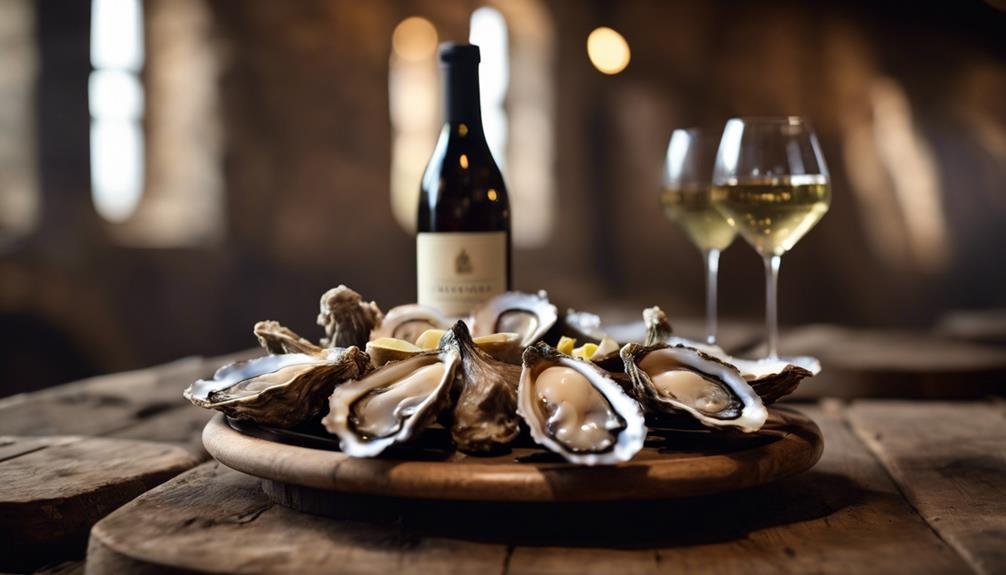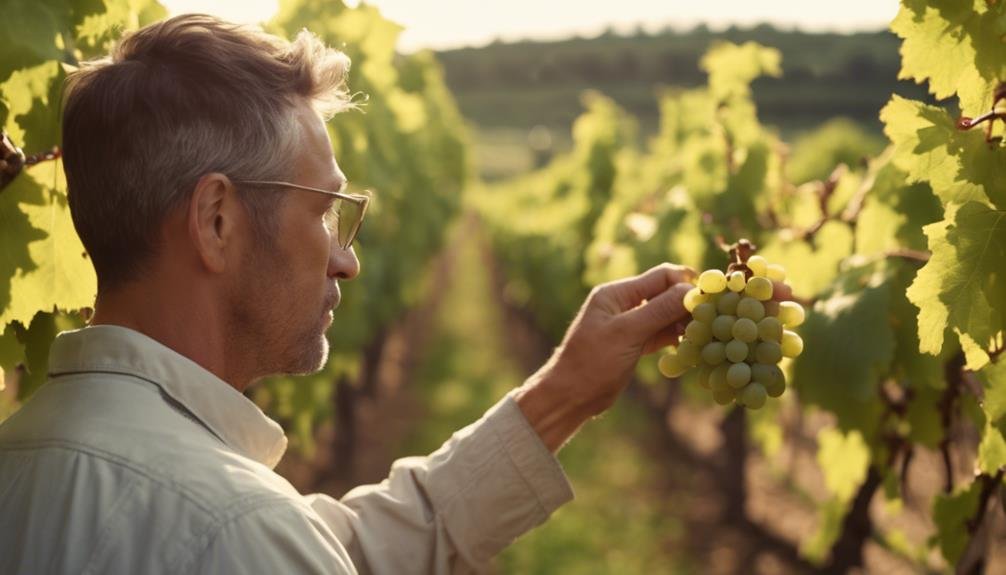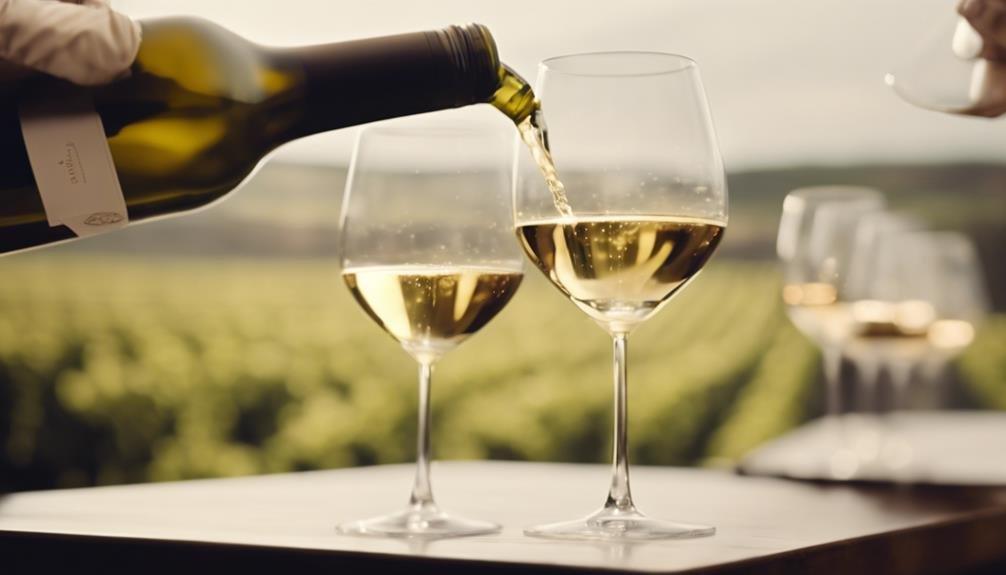Explore the alluring world of White Burgundy to uncover the mysteries of French Chardonnay. Terroir secrets infuse distinct flavors into these wines, while varied winemaking techniques add depth. Regions like Mâconnais offer light styles, while Côte de Beaune showcases oak-influenced varieties. Affordable options like Bourgogne Blanc and Mâconnais provide value at $15-$20. Pair Bourgogne Blanc with chicken, Mâconnais with mid-weight dishes, and Chablis with seafood delicacies. Vintage variations, such as the exceptional 2010, demand attention from collectors. Understanding nuances and seeking expert advice are key to investing in these esteemed wines. Unravel more about the intriguing world of White Burgundy.
Production Areas and Regions
White Burgundy wines are crafted in various production areas and regions within Burgundy, each offering distinct characteristics and flavor profiles. Terroir influence, winemaking techniques, climate impact, and soil composition play vital roles in shaping these wines.
The diverse terroir of Burgundy, encompassing different soils like limestone, marl, and clay, contributes to the unique flavors found in each subregion. Winemaking techniques, such as oak aging in Côte de Beaune, further enhance the complexity of these Chardonnay wines.
The cool climate of Chablis results in wines with high acidity and mineral notes, while the warmer Mâconnais region produces fruit-forward styles. Understanding the nuances of each Burgundy subregion allows wine enthusiasts to appreciate the diversity and quality that French Chardonnay has to offer.
Flavor Profiles and Buying Tips
When exploring the world of Burgundy Chardonnay, one can discern distinctive flavor profiles and valuable buying tips that enhance the overall wine tasting experience. White Burgundy offers a spectrum of flavors ranging from light and fruity to rich and oaked options.
Bourgogne Blanc and Mâconnais present light-bodied choices with fresh apple, lemon, and citrus notes, ideal for those seeking affordable and easy-drinking wines. On the other hand, Côte de Beaune showcases oak-aged varieties with powerful apple and truffle aromas, catering to those willing to invest in premium bottles.
For budget options, Bourgogne Blanc and Mâconnais wines priced between $15-$20 per bottle provide excellent value without compromising on quality, making them suitable choices for everyday enjoyment.
Food Pairing and Cellaring Guidelines

In the domain of Burgundy Chardonnay, understanding ideal food pairings and cellaring practices is essential for maximizing the enjoyment and potential of these wines.
When it comes to food pairing suggestions, Bourgogne Blanc complements chicken dishes and casual evenings, while Mâconnais pairs well with middle-weight dishes and cured pork products. Chablis shines with oysters and raw bar dishes due to its high acidity, and Côte de Beaune is best enjoyed with rich fish dishes, pork, chicken, and cream sauces.
Regarding cellaring techniques, these wines vary in aging potential. Bourgogne Blanc and Mâconnais are generally best consumed within a few years, while Chablis and Côte de Beaune can benefit from aging to enhance their flavor notes.
Vintage Variations and Collector Tips
Understanding the nuances of vintage variations in Burgundy Chardonnay is key for wine collectors seeking to appreciate the diverse expressions and qualities offered by different years.
It is essential to note the trend of premature aging in Burgundy wines since the mid-1990s, emphasizing the importance of selecting reputable producers known for consistency.
When building a collection, focus on exceptional vintages like 2010, which offer outstanding quality and aging potential.
By understanding the characteristics of each vintage and considering factors such as weather conditions and winemaking practices, collectors can make informed decisions on which bottles to acquire for their cellars.
Keep in mind that value can vary based on the vintage, making it imperative to research and seek guidance from experts when investing in White Burgundy wines.
Additional Information

An insight into Morgan Harris, a New York City-based sommelier, sheds light on the profound connection he emphasizes between wine and its enthusiasts. Harris, known for his passion for wine education, has been instrumental in bridging the gap between consumers and the intricate world of wine.
His expertise extends beyond the mere tasting notes, delving into the stories and experiences that each bottle encapsulates. Through his work, Harris not only imparts knowledge but also fosters a deeper appreciation for the artistry and craftsmanship behind winemaking.
His approach resonates with individuals seeking to enhance their understanding of wine, creating a community of like-minded enthusiasts who value the connection between what's in the glass and the emotions it evokes.
Frequently Asked Questions
Can White Burgundy Wines Be Aged in Stainless Steel Tanks?
White Burgundy wines can be aged in stainless steel tanks as an oak alternative. Stainless steel benefits include preserving fruit purity, enhancing acidity, and creating a clean, crisp finish. This method is preferred for showcasing a wine's natural characteristics.
Are There Any Organic or Biodynamic White Burgundy Producers?
Several reputable white Burgundy producers embrace organic certification and biodynamic farming practices, enhancing quality and sustainability. These methods prioritize environmental consciousness and enhance the unique terroir expression found in their wines, appealing to discerning consumers.
What Makes Chablis Wines Distinct From Other White Burgundies?
Chablis wines stand out within White Burgundy due to their distinct terroir-driven characteristics. Known for their unoaked style, Chablis exhibits vibrant lime-like mineral flavors, high acidity, and a unique crispness, showcasing minimal oak influence.
How Do Soil Types in Burgundy Affect the Taste of the Wines?
The diverse soil types in Burgundy, known as terroir, create distinct flavor profiles in wines. Vineyard management tailored to each soil type enhances grape quality, influencing the taste of White Burgundy. Soil nuances symbolize wine's complexity.
Is There a Specific Glassware Recommended for Enjoying White Burgundy Wines?
When enjoying White Burgundy wines, selecting proper stemware is essential. Opt for a glass with a wider bowl to enhance aromatics and allow aeration. Serve chilled but not too cold to fully appreciate the varietal's nuances.
Conclusion
To sum up, the intricate world of White Burgundy reveals the timeless allure of French Chardonnay. As we unravel the secrets behind its production and regions, we uncover a complexity that captivates wine enthusiasts worldwide.
From the distinct flavor profiles to vintage variations, each bottle offers a unique tasting experience. As we navigate the diverse offerings in the market, let us raise a glass to the irony that in simplicity lies the true complexity of White Burgundy.
Cheers to the hidden depths within each glass.
